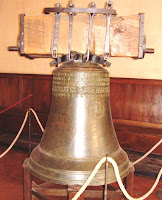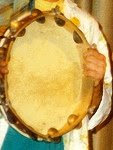| Name | Image | Tradition | Description |
|---|---|---|---|
| Agogo |  | Nigeria | An agogô (meaning gong or bell in Yoruba) is a single or multiple bell now used throughout the world but with origins in traditional Yoruba music and also in the samba baterias (percussion ensembles). The agogô may be the oldest samba instrument and was based on West African Yoruba single or double bells. The agogô has the highest pitch of any of the batería instruments. |
| Agung |  | Philippines | The agung is a Philippine set of two, wide-rimmed, vertically-suspended gongs used by the Maguindanao, Maranao and Tausug as a supportive instrument in their kulintang ensemble. The agung is also ubiquitous among other groups found in Mindanao, Sabah, Sarawak and Kalimantan as an integral part of their agung orchestra. |
| Amadinda |  | Uganda | Amadinda is a log xylophone from the Ugandan kingdom of Buganda. It consists of 12 wooden bars placed on two fresh banana stems. Sticks are inserted into the stems as separators between the bars. The bars are normally made from the wood of the Lusamba tree (Markhamia plarycalyx). The amadinda (or madinda) is played by three musicians called omunazi, omwawuzi and omukoonezi, respectively. One of these sits on one side of the xylophone, the other two on the other. Different seating arrangements are possible. Amadinda is used in the courtly music of the Kabaka, the king of Buganda. |
| Angklung |  | Indonesia | Angklung is a musical instrument made out of two bamboo tubes attached to a bamboo frame. The tubes are carved so that they have a resonant pitch when struck. The two tubes are tuned to octaves. The base of the frame is held with one hand while the other hand shakes the instrument rapidly from side to side. This causes a rapidly repeating note to sound. Thus each of three or more angklung performers in an ensemble will play just one note and together complete melodies are produced. |
| Antique Singing Bowls |  | Tibet | Traditionally, antique singing bowls were made of Panchaloga (literally meaning "five metals" in Sanskrit): an alloy of bronze, copper, tin, zinc and other metals. Antiques often include silver, gold, iron and nickel. Antique singing bowls produce multiphonic and polyharmonic overtones which are unique to the antique instruments. The subtle yet complex multiple harmonic frequencies are a special quality of the high quality bronze alloy. The art of making singing bowls in the traditional way is considered a lost art. Antique singing bowls are highly prized and collected worldwide. Their popularity is due to their fine craftsmanship and remarkable sound. |
| Aslato |  | Ghana | The aslato (also known as Kashaka) is a set of two small gourds (stones inside) tying together with a string. One gourd is held in the palm and the other is swung from side to side around the hand to hit the other gourd hard. It is an incredibly versatile instrument that creates an infinite number of beats and polyrhythms. A handful of musicians are able to play two sets of aslato at the same time. |
| Babendil |  | Philippines | The babendil is a single, narrow-rimmed Philippine gong used primary as the “timekeeper” of the Maguindanao kulintang ensemble. The babendil usually has a diameter of roughly one foot making it larger than the largest kulintang gong and comparable to the diameter of the agung or gandingan. The babendil could be played while standing or when seated with the babendil hung half a foot from the floor. |
| Balafon |  | Mali | The balafon (bala, balaphone) is a resonated frame, wooden keyed percussion idiophone of West Africa. It’s a xylophone made with strips of wood, increasing in length, connected together with thread, and with hollow gourd resonators of varying sizes attached to the bottom to achieve a greater tonal range. Sound is produced by striking the tuned keys with two padded sticks. The image shows a young Mali balafon player. |
| Bell |  | Europe | The bell is a percussion instrument and an idiophone. Its form is usually an open-ended hollow drum which resonates upon being struck. The striking implement can be a tongue suspended within the bell, known as a clapper, a small, free sphere enclosed within the body of the bell, or a separate mallet. Bells are usually made of cast metal, but small bells can also be made from ceramic or glass. Bells can be of all sizes: from tiny dress accessories to church bells weighing tons. The image shows the La Piagnona bell, from San Marco Museum in Florence Italy. |
| Bell Tree |  | United States | A bell tree is a percussion instrument, consisting of vertically nested metal bowls. The bowls are placed on a vertical rod with the smallest on the bottom and the rounded part facing up. They are played with a triangle beater or a glockenspiel mallet by sliding the mallet down the tree, producing an effective glissando. |
| Bianqing |  | China | The bianqing (Chinese: 編磬) is an ancient Chinese musical instrument consisting of a set of L-shaped flat stone chimes, played melodically. The chimes were hung in a wooden frame and struck with a mallet. Along with the bronze bells called bianzhong, they were an important instrument in China's ritual and court music going back to ancient times. A similar instrument was imported to Korea, where it is called pyeongyeong and still used in Korean court and ritual music. |
| Bianzhong |  | China | Bianzhong (編鐘) is an ancient Chinese musical instrument consisting of a set of bronze bells, played melodically. The bells were hung in a wooden frame and struck with a mallet. Along with the stone chimes called bianqing, they were an important instrument in China's ritual and court music going back to ancient times. |
| Bo Cymbals |  | China | The bo (bronze cymbals) were frequently used in Sui and Tang dynasties (AD 581-907) with varying designs. Now it is commonly made of high-tin bronze. The performer strikes the cymbals together. The most common type now is the jingbo (the prefix jing referring to Beijing, the prefix used to define the instruments in the Beijing opera). This type is clear and forceful in tone quality. It is also used in other regional opera genres and ensembles, and is one of the four major instruments (drum, large and small gongs and cymbals) in the jubilant luogu (锣鼓) (gong and drum) music. |
| Bonang |  | Indonesia | The bonang is a musical instrument used in the Javanese gamelan. It is a collection of small gongs (sometimes called "kettles" or "pots") placed horizontally onto strings in a wooden frame (rancak), either one or two rows wide. All of the kettles have a central boss, but around it the lower-pitched ones have a flattened head, while the higher ones have an arched one. Each is tuned to a specific pitch in the appropriate scale; thus there are different bonang for pelog and slendro. They are typically hit with padded sticks (tabuh). This is similar to the other cradled gongs in the gamelan, the kethuk, kempyang, and kenong. |
| Bones |  | Ireland | The bones are a folk instrument which, at the simplest, consists of a pair of animal bones, or pieces of wood or a similar material. Sections of large rib bones and lower leg bones are the most commonly used true bones, although wooden sticks shaped like the earlier true bones are now more often used. They have contributed to many music genres, including 19th century minstrel shows, traditional Irish music, the blues, bluegrass, zydeco, French-Canadian music, and music from Cape Breton in Nova Scotia. The image shows a painting titled "The Bone Player" by William Sidney Mount, 1856. |
| Buben |  | Russia | Buben (Бубен in Russian, Бубон in Ukrainian, buben in Czech, bęben in Polish) is a musical instrument of the percussion family similar to a tambourine. A buben consists of a wooden or metal hoop with a tight membrane stretched over one of its sides (some bubens have no membrane at all). Certain kinds of bubens are equipped with clanking metal rings, plates, cymbals, or little bells. It is held in the hand and can be played in numerous ways, from stroking or shaking the jingles to striking it sharply with hand. It is used for rhythmical accompaniment during dances, soloist or choral singing. Buben is often used by some folk and professional bands, as well as orchestras. |
| Cabasa |  | Brazil | The cabasa, similar to the shekere, is a percussion instrument that is constructed with loops of steel ball chain wrapped around a wide cylinder. The cylinder is fixed to a long, narrow wooden or plastic handle. It was constructed from dried oval- or pear-shaped gourds with beads strung on the outer surface. The image shows an afuche-cabasa. |
| Calabash |  | Mali | Large calabashes are used as percussion instruments after they are hollowed and dried, especially by Fulani (an ethnic group of people spread over many countries in West Africa, Central Africa and as far as East Africa), Songhai (an ethnic group from western Africa akin to the Mandé), Gur-speaking (the Niger-Congo languages) and Hausa peoples (a Sahelian people chiefly located in the West African regions of northern Nigeria and southeastern Niger). |
| Calung |  | Indonesia | A calung is a bamboo tube xylophone used by the Sundanese people of West Java. It can have from 2 to 19 tubes connected by two cords. Jegog is a form of gamelan music indigenous to Bali, Indonesia played on instruments made of bamboo. All instruments have eight bamboo keys. Some instruments have two keys for each pitch slightly detuned so that the pitches beat when they are played together. |
| Carillon |  | Belgium | A carillon is a musical instrument composed of at least 23 cup-shaped bells played from a baton keyboard using fists and feet (such an instrument with fewer than this number of bells is known as a chime). Carillon bells are made of bell bronze, approximately 78% copper and 22% tin. They could be housed in bell towers, shopping malls, Opera houses or theatres such as the one at the Bolshoi Theatre in Moscow. |
| Castanet |  | Spain | Castanets are percussion instrument (idiophone), much used in Moorish, Ottoman, Ancient Roman, Italian, Spanish, Portuguese and Latin American music. The instrument consists of a pair of concave shells joined on one edge by string. These are held in the hand and used to produce clicks for rhythmic accents or a ripping or rattling sound consisting of a rapid series of clicks. They are traditionally made of hardwood, although fibreglass is becoming increasingly popular. Spanish castanets are called Castañuelas. Portuguese castanets are called Castanholas. |
Prev Top Next |